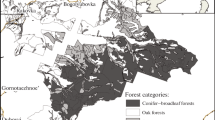Abstract
In the Bialowieża Primeval Forest a decrease in the extent of the Potentillo-albae Quercetum has been observed for the last few decades, both with regard to the number of stands and size of the remaining phytocoenoses. In this paper the decline of an oak forest stand is analysed in terms of species richness, species frequency, spatial pattern and proportion of various ecological groups in the patch. Investigations were carried out from 1969 to 1992 on a permanent plot of 512 square meters divided into 128 quadrats. During this period: 1) 60 species disappeared from the plot whereas only 4 species invaded it; 2) frequency of most species considerably decreased; 3) species diversity decreased; 4) spatial homogeneity of the patch increased; 5) the number of species per unit area markedly decreased; 6) domination structure changed: the proportion of hornbeam-forest species was constantly increasing, eventually reaching the value comparable to that recorded for hornbeam forests. Finally, the oak forest was replaced by a community resembling hornbeam forest, with a small proportion of heliophilous species.
Similar content being viewed by others
References
Borowski, S. & Kossak, S. 1972. The natural food preferences of the European bison in seasons free of snow cover. Acta Theriol. 17: 151–169.
Borowski, S. & Kossak, S. 1975. The food habits of deer in the Bialowieża Primeval Forest. Acta Theriol. 20: 463–506.
Calleja, M., Dagnelie, P. & Gounot, M. 1962. Étude statistique d'une peluse a Brachypodium ramosum. Bull. Serv. Carte Phytogéogr. Ser. B. 7. 1.
Ehrendorfer, F. 1973. Liste der Gefasspflanzen Mitteleuropas. G. Fisher, Stutgart.
Faliński, J. B. 1986. Vegetation dynamics in temperate lowland primeval forests. Junk, Dordrecht.
Faliński, J. B. 1988. Succession, regeneration and fluctuation in the Bialowieża Forest (NE Poland). Vegetatio 77: 115–128.
Karpiński, J. J. 1949. Materialy do bioekologii Puszezy Bialowieskiej. Rozprawy i Sprawozdania IBL ser. A, nr 56. IBL, Warszawa.
Kossak, S. 1981. Development of food habits in roe deer. Acta Theriol. 26: 483–494.
Kwiatkowska, A. J. 1972. Analiza homogeniczności runa fitocenozy przy zastosowaniu nieparametrycznego testu serii. Phytocoenosis 1: 37–77.
Kwiatkowska, A. J. 1986. Reconstruction of the old range and the present-day boundary of a Potentillo albae-Quercetum (Libb.) 1933 phytocoenosis in the Bialowieża Primeval Forest landscape. Ekol. pol. 34: 31–45.
Kwiatkowska, A. J. & Wyszomirski, T. 1988. Decline of Potentillo albae-Quercetum phytocoenoses associated with the invasion of Carpinus betulus. Vegetatio 75: 49–55.
Kwiatkowska, A. J. & Wyszomirski, T. 1990. Species deletion in Potentillo albae-Quercetum phytocoenoses reversed by the removal of Carpinus betulus. Vegetatio 87: 115–126.
Matuszkiewicz, A. 1955. Stanowisko systematyczne i tendencje rozwojowe dabrów bialowieskich. Acta Soc. Bot. Pol. 23: 459–494.
Matuszkiewicz, A. 1977. Der Thermophile Eichenwald in NO-Polen als Anthropo-zoodene Gesellschaft. In: Tüxen, R. (ed.), Vegetation und fauna. J. Cramer, Vaduz.
Matuszkiewicz, W. 1981. Przewodnik do oznaczania zbiorowisk roślinnych Polski. PWN, Warszawa.
Paczoski, J. 1926. Dabrowy Bialowiezy. Przeglad Leśniczy (1926): 517–529.
Sokal, R. R. & Rohlf, F. J. 1981. Biometry. Freeman, San Francisco.
Author information
Authors and Affiliations
Rights and permissions
About this article
Cite this article
Kwiatkowska, A.J. Changes in the species richness, spatial pattern and species frequency associated with the decline of oak forest. Vegetatio 112, 171–180 (1994). https://doi.org/10.1007/BF00044691
Accepted:
Issue Date:
DOI: https://doi.org/10.1007/BF00044691



